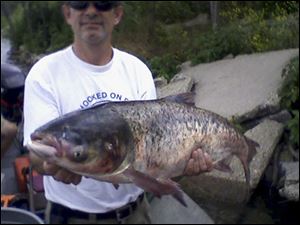
Politicians ignoring Asian carp threat
7/22/2012
Asian carp DNA has been found in both Sandusky and Maumee bays, but officials still haven't found a solution.
The Great Lakes have been subjected to a rather notorious list of invasive species over the last half century or so. Line them up and they look like characters that were rejected for the next Tim Burton movie.
The rusty crayfish, spiny water flea, round goby, Eurasian ruffe, sea lamprey, white perch, quagga mussel, purple loosestrife, curly-leaf pondweed, zebra mussel, Eurasian watermilfoil, and these two Hollywood villain-sounding scallywags: phragmites and viral hemorrhagic septicemia virus. They all are aliens to our ecosystem, but they all live here now.
Then along came the alpha dog of all invaders, the Asian carp. Word of its spread up the Mississippi River system induced near panic in the ranks of the biologists and scientist familiar with this ultra-aggressive and ultra-prolific exotic species.
There were meetings, symposiums, conferences, studies, reports, committees and subcommittees, forums, surveys, research, panel discussions, public hearings, debates, and consultations.
Meanwhile, back on the Mississippi, the carp kept coming.
The grim warnings continued to flow from the troops in the field, and the soap-box jumping and buck-passing continued on the political front.
And the carp swam on.
Now the dark, carp-filled clouds that have loomed on the horizon seem to have moved in overhead. Asian carp DNA has been detected numerous times in the waters above an electrical barrier in Chicago that was supposedly designed to keep the carp from using that man-made superhighway that connects the Mississippi River system to Lake Michigan.
Asian carp DNA has also shown up in the Lake Erie waters of Sandusky Bay and Maumee Bay. Meanwhile, on the official front, we are still studying the problem, forming committees, and looking for solutions.
The environmental watchdogs who have been sounding the alarm for well over a decade are understandably disgusted with the apparent lack of political will to apply the appropriate fix, no matter how painful or how politically bitter it might taste in the area around ground zero -- that Chicago waterway.
"We've known about this problem and this threat for a very long time, and I was letting the powers that be take care of it. Now, that clearly is not enough," said Sandy Bihn of the Lake Erie Waterkeeper organization.
"We've had the gobies and zebra mussels get in the lakes and then just take off, and we've had to live with the consequences. But this one is different. This one is so much more threatening."
Jeff Alexander, an award-winning journalist based in Michigan who has covered the environmental woes of the Great Lakes for two decades, shares Bihn's exasperation over the endless deliberation on this issue, while the carp keep surging north.
"They've known for many years that these fish were headed our way, and we've certainly done lots of studies, but very little has been done in terms of action," Alexander said.
"For the Great Lakes, this might be the biggest threat they have ever faced from an invasive species, but the action level on the part of our government has not matched that threat level. If the threat is as big as the biologists say it is, then why hasn't the government dropped everything and addressed this."
After watching the way the exotic mussels have exploded in population and altered the ecosystems in the Great Lakes and many other U.S. waters, and how the round gobies have just become an accepted major nuisance in Lake Erie, Bihn fears what could be in Lake Erie's immediate future.
"What do we do -- do we just let these Asian carp take over and just give up our whole fishery," she asked. "This DNA thing is a wake-up call. Yes, another wake-up call."
But the alarm might not be loud enough and annoying enough to arouse that sleeping giant named political will.
"The idea that government hasn't responded -- it follows a pattern. Warnings are ignored," said Alexander, who is a regular contributor to the National Wildlife Federation publications and Web site.
"To me, this is a clear and present danger, and the Army Corps of Engineers is still studying the issue. There is an environmental and financial disaster looming here, and once these fish get in, they are never going away. It's very hard to be optimistic at all."
It is the Corps that is charged with addressing the Asian carp threat, and recommending then implementing a fix. The Corps' approach has been too plodding, too snarled in red tape and bureaucratic gobbledygook for many in Western Lake Erie.
At the recent "Taste of Chicago" food fair, officials from the Corps teamed up with the Illinois Department of Natural Resources and the John G. Shedd Aquarium to serve Asian carp sliders for free to the assembled crowds. The groups involved in the odd promotional effort touted how "a vibrant local market for Asian carp contributes to managing the population of this invasive species".
In Western Lake Erie, it's doubtful that developing a taste for Asian carp is anywhere on the menu.
Contact Blade outdoors editor Matt Markey at: mmarkey@theblade.com or 419-724-6068.